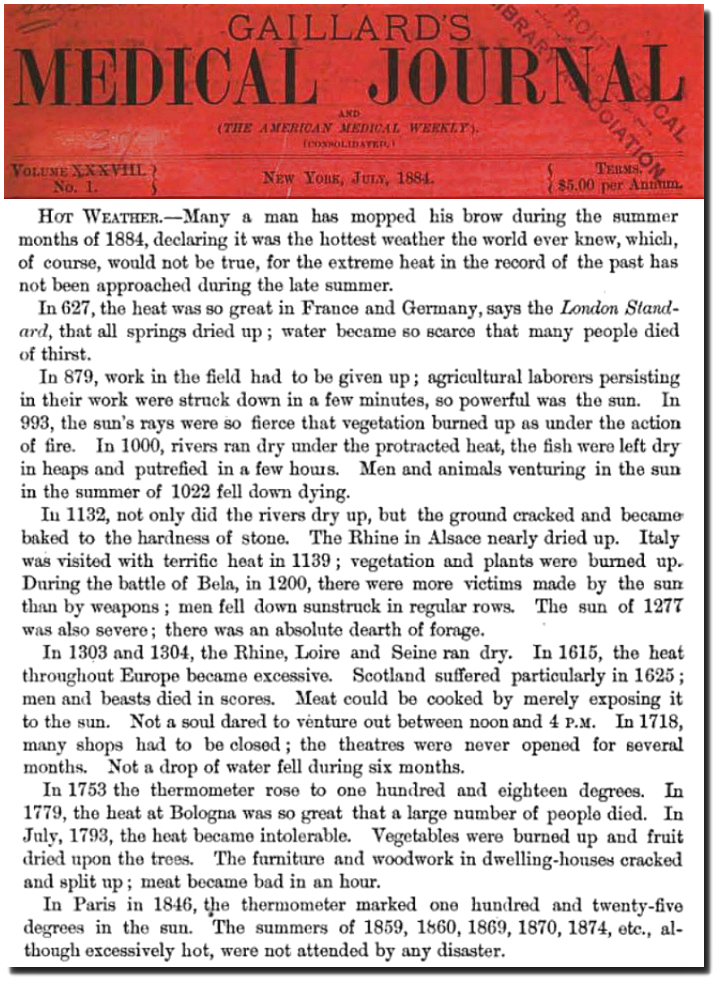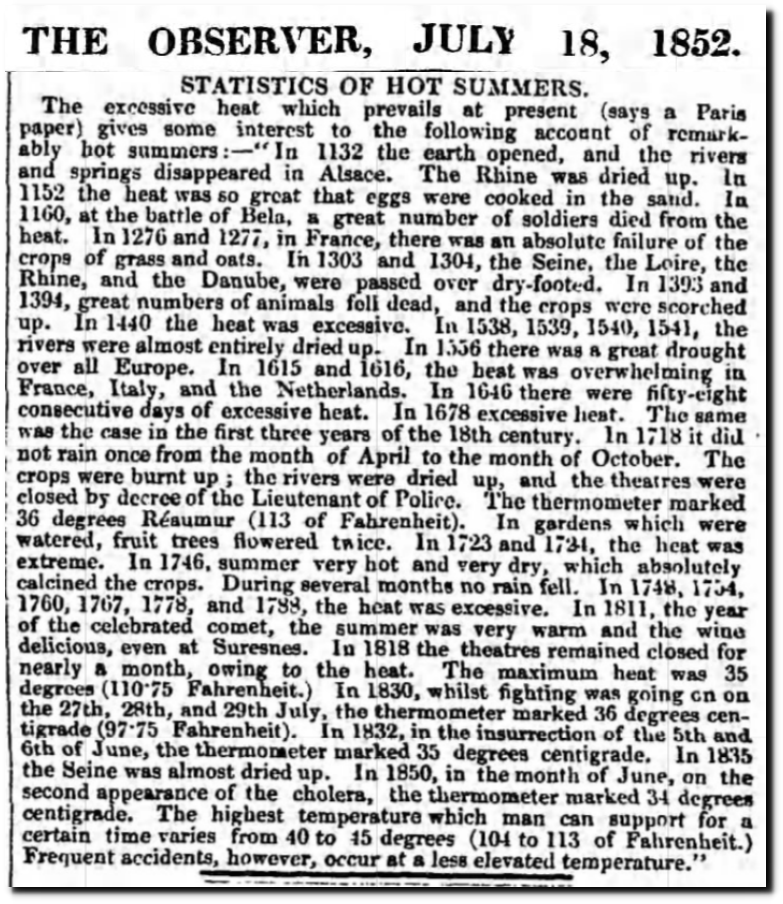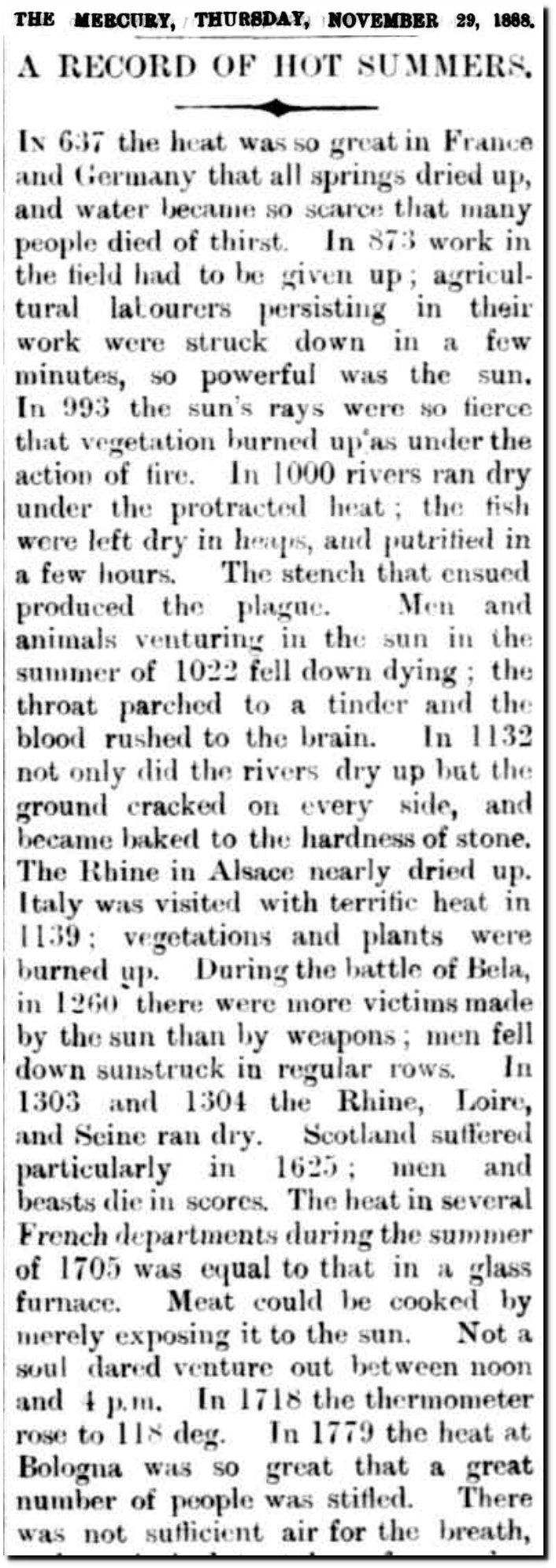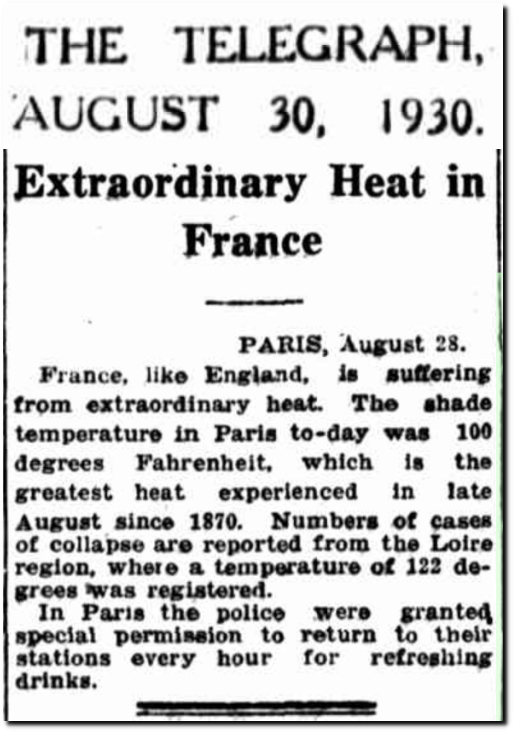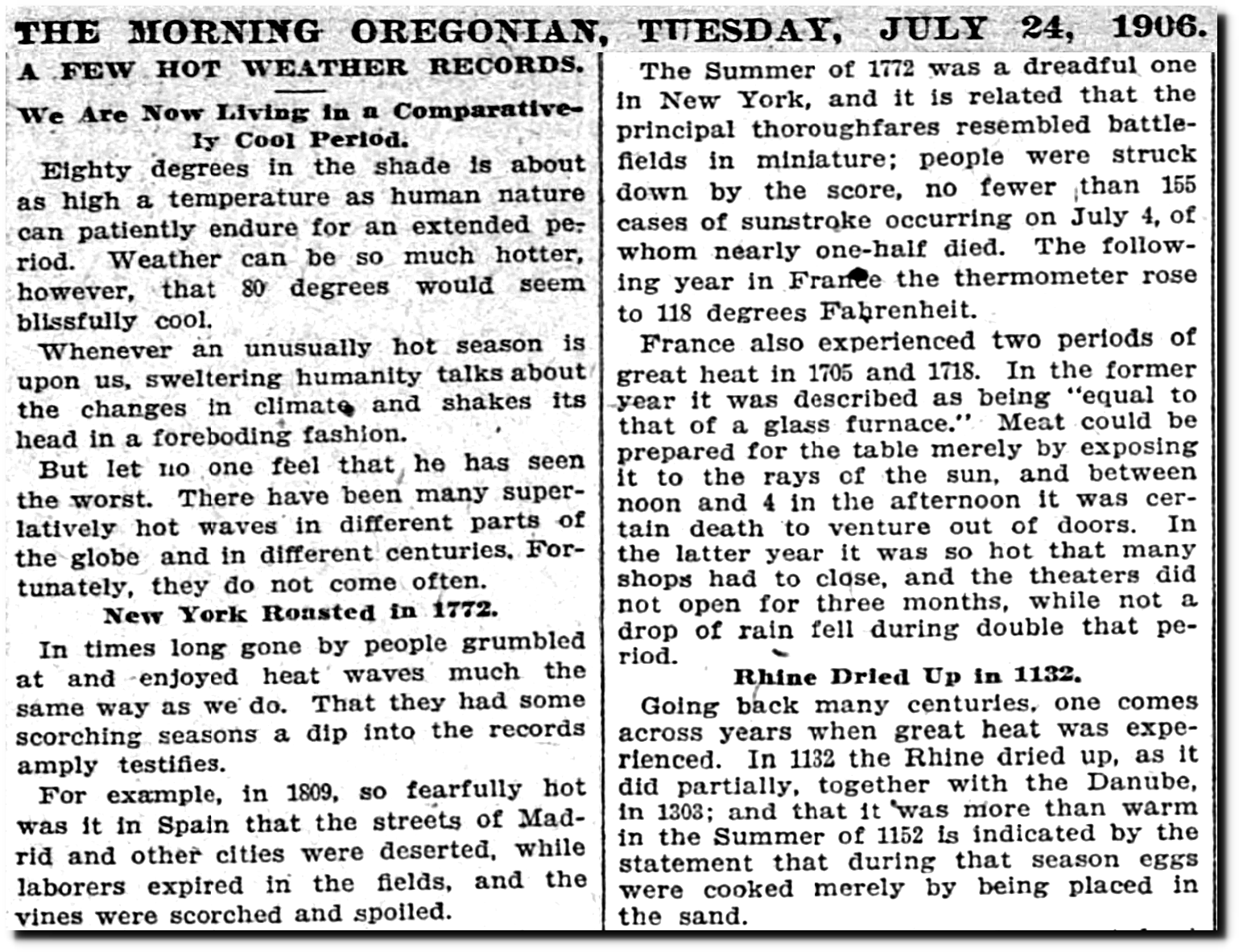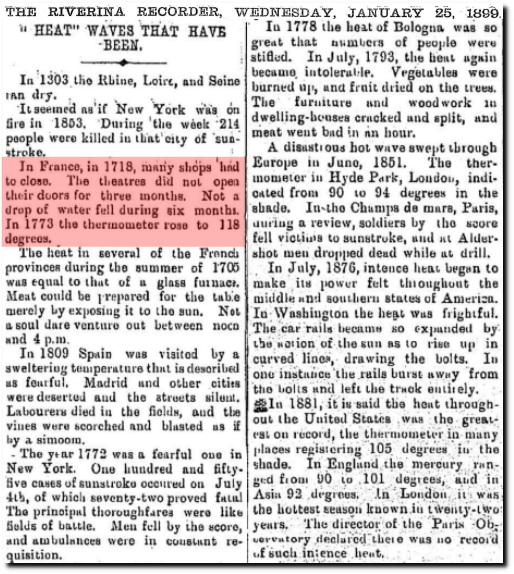The Prime Minister of France says global warming has caused the worst drought in the history of France, and it is caused by the burning of fossil fuels.


French prime minister vows to fight inflation, climate change
Apparently the history of France is much shorter than most people realized.
“Hot Weather.—Many a man has mopped his brow during the summer months of 1884, declaring it was the hottest weather the world ever knew, which, of course, would not be true, for the extreme heat in the record of the past has not been approached during the late summer.
In 627, the heat was so great in France and Germany, says the London Standard, that all springs dried up; water became so scarce that many people died of thirst.
In 879, work in the field had to be given up; agricultural laborers persisting in their work were struck down in a few minutes, so powerful was the sun. In 993, the sun’s rays were so fierce that vegetation burned up as under the action of fire. In 1000, rivers ran dry under the protracted heat, the fish were left dry in heaps and putrefied in a few hours. Men and animals venturing in the sun in the summer of 1022 fell down dying.
In 1132, not only did the rivers dry up, but the ground cracked and became baked to the hardness of stone. The Rhine in Alsace nearly dried up. Italy was visited with terrific heat in 1189; vegetation and plants were burned up. During the battle of Bela, in 1200, there were more victims made by the sun than by weapons ; men fell down sunstruck in regular rows. The sun of 1277 was also severe; there was an absolute dearth of forage.
In 1303 and 1304, the Rhine, Loire and Seine ran dry. In 1615, the heat throughout Europe became excessive. Scotland suffered particularly in 1625 ; men and beasts died in scores. Meat could be cooked by merely exposing it to the sun. Not a soul dared to venture out between noon and 4 p.m. In 1718, many shops had to be closed; the theatres were never opened for several months. Not a drop of water fell during six months.
In 1753 the thermometer rose to one hundred and eighteen degrees. In 1779, the heat at Bologna was so great that a large number of people died. In July, 1793, the heat became intolerable. Vegetables were burned up and fruit dried upon the trees. The furniture and woodwork in dwelling-houses cracked and split up; meat became bad in an hour.
In Paris in 1846, the thermometer marked one hundred and twenty-five degrees in the sun. The summers of 1859, 1860, 1869, 1870, 1874, etc., although excessively hot, were not attended by any disaster.”
Gaillard’s Medical Journal – Google Books
“STATISTICS OF HOT SUMMERS.
The excessive heat which prevail. at present (says a Paris paper) gives some interest to the following account of remarkably bot summers :—” In 1132 the earth opened, and the rivers and spring; disappeared in Alsace. The Rhine was dried up. In 1152 the heat was to great that eggs were cooked in the sand. In 1160, at the battle of Bela, a great number of soldiers died from the heat. In 1276 and 1277, in France, there was an absolute failure of the crops of grass and oats. In 1303 and 1304, the Seine, the Loire, the Rhine, and the Danube, were passed over dry-footed. In 1393 and 1394, great numbers of animals fell dead, and the crops were scorched up. In 1440 the heat was excessive. In 1538, 1539, 1540, 1541, the rivers were almost entirely dried up. In 1556 there was a great drought over all Europe. In 1615 and 1616, the heat was overwhelming in France, Italy, and the Netherlands. In 1646 there were fifty-eight consecutive days of excessive heat. In 1678 excessive heat. The same was the case in the first three years of the 18th century. In 1718 it did not rain once from the month of April to the month of October. The crops were burnt up ; the riven were dried up, and the theatres were closed by decree of the Lieutenant of Police. The thermometer marked 36 degrees Reaumur (113 of Fahrenheit). In gardens which were watered, fruit trees flowered twice. In 1723 and 1724, the heat was extreme. In 1746. summer very hot and very dry, which absolutely calcined the crops. During several months no rain fell. In 1748, 1754, 1760, 1767, 1778, and 1749, the heat was excessive. In 1811, the year of the celebrated comet, the summer was very warm and the wine delicious, men at Semmes. In 1818 the theatres contained closed for nearly a month, owing to the heat. The maximum heat was 35 degrees (110.75 Fahrenheit.) In 1830, whilst fighting was fining on on the 27th. 28th, and 29th July, the thermometer marked 36 degrees centigrade (97.75 Fahrenheit). In 1832, in the insurrection of the 5th and 6th of June, the thermometer marked 35 degrees centigrade. In 1695 the Seine was almost dried up. In 1850, in the month of June, on the second appearance of the cholera, the thermometer marked 34 degrees centigrade. The highest temperature which man can support for a certain time varies from 40 to 45 degrees (104 to 113 of Fahrenheit.) Frequent accidents, however, occur at a less elevated temperature.”
18 Jul 1852, 7 – The Observer at Newspapers.com
“Summer Heat Precedents.
A German writer, dealing with certain prognostications (usually heard at this time of the year) of great summer heat, goes back for precedents. In 637, he says, the springs were dried up and men fainted with the heat. In 879 II was impossible to work in the open fields. In the year 993 the nuts on the trees were roasted, as if in a baker’s oven. In 1000 the rivers in France dried up, and the stench from the dead fish and other matter brought a pestilence into the land. The heat in the year 1014 dried up the rivers and the brooks In Alsace-Lorraine. The Rhine was dried lap in the year 1132. In he year 1152 the heat was eo great that eggs could be cooked in the sand. In 1227 it is re. corded that many men and animals came to their death through the intense heat. In the year 1303 the waters of the Rhine and the Danube were partially dried upend the people passed over on foot. The crops were burned no in the : year 1394, and in 1538 the Seine and Loire were as dry land. In 1536 a great drought swept through Europe. In 1 1014 in France, and even in Switzer-lard, the brooks and the ditches were dried up. Not less hot were the years 1048. 1779 and 1701. In the year 1715 • from the month of March till October not a drop of rain fell, the temperature arose to 38 degrees Reamer and in favored places the fruit trees blossomed a second time. Extraordinarily hot were the year. 1724, 1746, 1756 and 1811. The summer of 1815 was so hot -the thermometer standing at 40 degrees Reaumur -that the places of amusement had to he closed.—London Daily News.
The Day – Google News Archive Search
17 Jul 1852, 7 – The Hampshire Advertiser at Newspapers.com
“Dry Times in the Past.
The history of the world drouths goes back to the year 627, when in France and Germany thousands of human beings died of thirst.
In the year 1000 the rivers of Europe dried up and heaps of fish were left to putrify and spread the plague that followed.
In 1123 the Rhine river dried up in Alsace. During the battle of Bela, in 1260, more men died from heat than wounds.
In 1303 and 1304 the Rhine, the Loire and Seine rivers ran dry.
In 1779 many persons in Bologna were stifled. Shops all over Europe were closed for months.
In 1821 a plague of mice came with intolerable heat. More than 200,000 persons died from beat in France.”
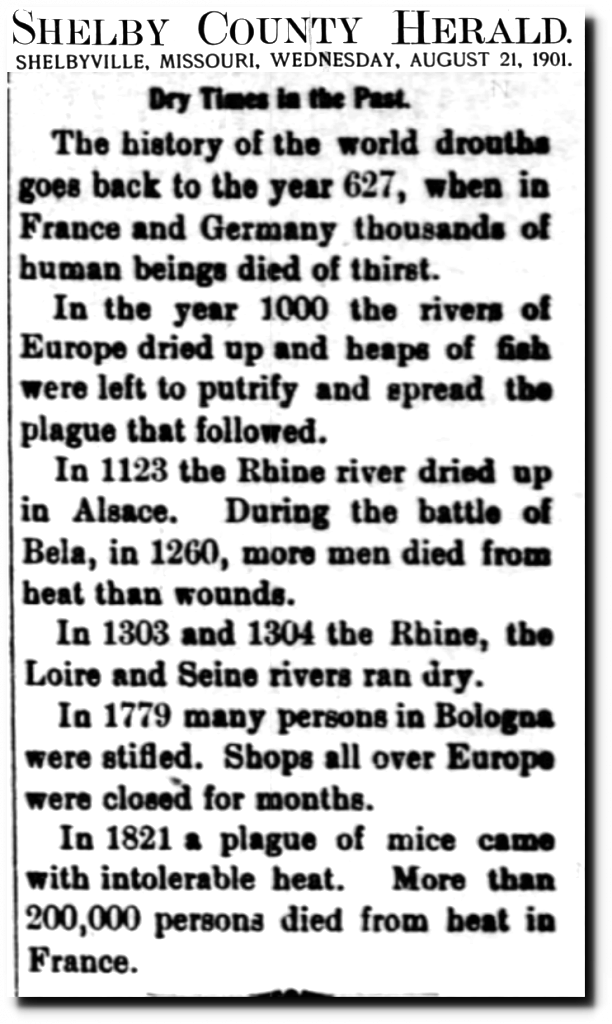
21 Aug 1901, Page 3 – Shelby County Herald at Newspapers.com
A RECORD OF HOT SUMMERS.
IN 637 the heat was so great in France and Germany that all springs dried up, and water became so scarce that many people died of thirst.
In 873 work in the field had to be given up ; agricultural labourers persisting in their work were struck down in a few minutes, so powerful was the sun.
In 993 the sun’s rays were so fierce that vegetation burned up as under the action of fire.
In 1000 rivers ran dry under the protracted heat ; the fish were left dry in heaps, and putrified in a few hours. The stench that ensued produced the plague.
Men and animals venturing in the sun in the summer of 1022 fell down dying; the throat parched to a tinder and the blood rushed to the brain.
In 1132 not only did the rivers dry up but the ground cracked on every side, and became baked to the hardness of stone. The Rhine in Alsace nearly dried up.
Italy was visited with terrific heat in 1139; vegetations and plants were burned up.
During the battle of Bela, in 1260, there were more victims made by the sun than by weapons; men fell down sunstruck in regular rows.
In 1303 and 1304 the Rhine, Loire, and Seine ran dry.
Scotland suffered particularly in 1625; men and beasts die in scores.
The heat in several French departments during the summer of 1705 was equal to that in a glass furnace. Meat could be cooked by merely exposing it to the sun. Not a soul dared venture out between noon and 4 p.m.
In 1718 the thermometer rose to 118 deg.
In 1779 the heat at Bologna was so great that a great number of people was stifled. There was not sufficient air for the breath, and people had to take refuge under-ground.
In July, 1793, the heat became intolerable. Vegetables were burned up, and fruit dried upon the trees. The furniture and woodwork in dwelling-houses cracked and split up; meat went bad in an hour.
The rivers ran dry in several provinces during 1811; expedients had to be devised for the grinding of corn.
In 1822 a protracted heat was accompanied by storms and earthquakes; during the drought legions of mice overran Lorraine and Alsace, committing incalculable damage.
In 1832 the heat brought about cholera in France; 20,000 persons fell victims to the visitation in Paris alone.
In 1846 the thermometer marked 125 deg. in the sun.
50C (122F) in 1930
p2 – 30 Aug 1930 – The Telegraph (Brisbane, Qld. : 1872 – 1947) – Trove
48C (118F) in 1773
“In 1303 the Rhine, Loire, and Seine ran dry.
‘It seemed as if New Work was on fire in 1853, ‘During ‘the week 214 people were killed in that city of sunstroke.
In France, in 1718, marry shops had to close, The theatres did not open their doors for three months, Not a drop of water fell during six months, In 1773 the thermometer rose to 118 degrees,
The heat in several of the French provinces during the summer of 1705 wus equal to that of a glass furnaces, Meat could be prepared for the tube merely by exposing it to the sun, Not a soul dared venture out between noon and 4 p.m.
In 1809 Spain was visited by a sweltering temperature that is described us fearful, Madrid and other cities were deserted and the streets silent, Labourers died in the fields, and the vines were scorched and blasted as if by a simoom.
The year 1772 was o fearful one in New York. One hundred and fifty- five cases of sunstroke occured on July 4th, of which seventy-two proved fatal. The principal thoroughfares were like fields of battle, Men fell by the score, and ambulances were in constant requisition.”

